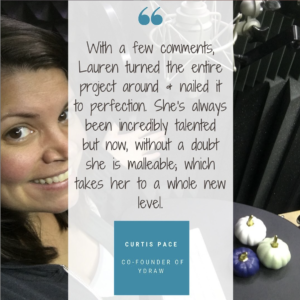This not-new-but-growing field is a great one for folks who want to do some good with their voice practice.
The federal government defines audio description like this:
 “Audio Description. Narration added to the soundtrack to describe important visual details that cannot be understood from the main soundtrack alone. Audio description is a means to inform individuals who are blind or who have low vision about visual content essential for comprehension. Audio description of video provides information about actions, characters, scene changes, on-screen text, and other visual content. Audio description supplements the regular audio track of a program. Audio description is usually added during existing pauses in dialogue. Audio description is also called “video description” and “descriptive narration”.”
“Audio Description. Narration added to the soundtrack to describe important visual details that cannot be understood from the main soundtrack alone. Audio description is a means to inform individuals who are blind or who have low vision about visual content essential for comprehension. Audio description of video provides information about actions, characters, scene changes, on-screen text, and other visual content. Audio description supplements the regular audio track of a program. Audio description is usually added during existing pauses in dialogue. Audio description is also called “video description” and “descriptive narration”.”
Different from Subtitles
This differs from other types of adaptive services like subtitles, since you need an earpiece or other sort of headset to hear the descriptions that let you know what’s going on.
There is more than one type of audio description, that which is pre-recorded and synched with the audio of the movie and fit into dialogue pauses, and the kinds that go along with live performances and are voiced as the performance goes on.
- For pre recorded media, there is one other type of description, called extended description. This is used with media that does not have frequent pauses, or has heavy visual elements that need a great deal of explanation. With this option, you can pause the action in the movie or show to play out the entire description before going on. Libraries will also sometimes have DVDs with recorded descriptions added to borrow.
- Other genres of audio description can be found in self guided museum tours or other visual art exhibits. Non-visually impaired people may enjoy this service also due to alternative processing needs when watching a movie, or other disabilities.
- Persons on the autism spectrum can use audio description to help understand interpersonal or emotional cues with the pairing of visual and auditory description. This helps them understand challenging areas with increased clarity.
- Children developing language can also benefit, since it improves their association with words and visual objects or events onscreen.
Audio for Visually Impaired
 Creating additional audio for blind people has an interesting history.
Creating additional audio for blind people has an interesting history.
There are a few early incidents of movie theaters doing special showings for blind people with live description as part of the program, but this was few and far between as technology continued to advance. Early media formats hindered the development of the service, since analog signals could only transmit one audio channel at a time. The American Council of the Blind includes some history of audio description, sharing “Credit for the “invention” of audio description in 1981 generally goes to the late Dr. Margaret Pfanstiehl and her late husband Cody, although in independent efforts a man named Chet Avery proposed the concept in the late 60s, and Gregory Frazier worked on the idea on the 1970s.
In 1990, the National Academy of Television Arts and Sciences awarded Margaret an Emmy for her “leadership and persistence in the development of television for the visually impaired.” In 2009, Margaret received the Excellence in Accessibility Leadership Award at the LEAD Conference at the Kennedy Center for her lifetime commitment and enduring advocacy on behalf of audio description and other forms of information access for the visually impaired community. Over the years, the Pfanstiehls personally trained hundreds of audio describers around the world. Since then, many of those trained describers have gone on to train other audio describers.
Accessibility
Disability advocacy has increased the type of assistive services available across the US, with many media producers making more efforts to include disabled folks in their creation but we still have a long way to go.
The government has moved back and forth on whether or not television stations have been required to provide audio description services. In 2002, it was ruled that the FCC did not have the authority to require stations to provide audio description. Then, in 2010, it was ruled again that the descriptions were within the FCC’s authority to require. Unfortunately, the FCC’s requirements for major stations to provide audio description does not cover all stations and all programming, so you may not be able to utilize this service for certain programming.
Increased Popularity
 Over the decades, audio description has become more and more popular as visually impaired people want to consume more television, but in the past they had to rely on friends or family members for description duties. In 1985, WGBH in Boston started providing audio description services for PBS programming due to this. After running tests and reviewing studies, they created an organization called Descriptive Video Services to match up with PBS programming.
Over the decades, audio description has become more and more popular as visually impaired people want to consume more television, but in the past they had to rely on friends or family members for description duties. In 1985, WGBH in Boston started providing audio description services for PBS programming due to this. After running tests and reviewing studies, they created an organization called Descriptive Video Services to match up with PBS programming.
As time passed, DVS programming has continued to expand, going beyond PBS services. Not all stations offer it, as the FCC’s requirements only apply to the major network stations and not to smaller stations or syndicated programming. Many stations choose to run a Spanish dubbing track rather than one for the visually impaired. Some of the streaming services are moving forward with offering audio description, but none of them do as of early 2021. There are now also many other companies, both for and non-profit that provide this service to interested media creators.
Opportunities for Voiceover Beginners and Seasoned Pros
Audio description is a great way for beginning voice talent to offer their services on a volunteer basis with non-profit companies while you learn your craft.
Veteran talent can also pursue paid projects through companies like Netflix that are utilizing audio description to make their content more accessible to a their audience.
There are a great many companies that provide this kind of services for media creators. Anyone interested can look on this page at the American Council of the Blind with Training or Education resources. There is also a great deal of information on organizations that offer audio description services, and you can look on this page to find out more information. Some of them will offer training or testing programs to get started. This is a type of service that will never run out of need, since not only are there constantly new shows and movies to describe, there are also oceans of older media that needs a run down. Once you are familiar with the voicing process for this type of work, you can also get your name on the list of voiceover rosters that have experience in that area on the ACB’s website.
 A thousand and one times in any given week in any voiceover group online, you’ll see one type of question from newbies worldwide.
A thousand and one times in any given week in any voiceover group online, you’ll see one type of question from newbies worldwide.  Well, the first thing you want to do is get a sense of your budget.
Well, the first thing you want to do is get a sense of your budget.  DAW
DAW Know your message and audience
Know your message and audience Get your music ready
Get your music ready Referral marketing is often thrown into lists of great marketing ideas, but have you taken the time to explore how to set up a referral program for your business?
Referral marketing is often thrown into lists of great marketing ideas, but have you taken the time to explore how to set up a referral program for your business? 
 The single biggest thing you need to make sure to center in your website building is readability. Fonts and fun colors are awesome, but many people find certain color combinations or font choices difficult to read. Sometimes these choices are even headache inducing, especially for older folks. People who have vision correction can also find funky colors and fonts a challenge also. Be sure that you source people on different computers, using different browsers, on mobile and whatever other types you can think of to make sure that everything displays correctly and is easy to follow.
The single biggest thing you need to make sure to center in your website building is readability. Fonts and fun colors are awesome, but many people find certain color combinations or font choices difficult to read. Sometimes these choices are even headache inducing, especially for older folks. People who have vision correction can also find funky colors and fonts a challenge also. Be sure that you source people on different computers, using different browsers, on mobile and whatever other types you can think of to make sure that everything displays correctly and is easy to follow.  You’d think this would be a given, but there are sites out there where it’s nearly impossible to find out how to contact a particular talent. Don’t hide your contact info at the bottom of the page in faint text, get that info out there loud and proud! If you’re not comfortable with your home or cell number being visible online, there are many services like Google Voice that allow you to create an easy free forwarding number. And it’s no challenge these days to create a forwarding email if you want to give yourself a step removed from any spam you might get. Contact info for your agents can be useful here too if you typically book work through them. Avoid contact forms unless you have a particular need for them, since they seem really impersonal, and you are making your potential client jump through another hoop to reach you.
You’d think this would be a given, but there are sites out there where it’s nearly impossible to find out how to contact a particular talent. Don’t hide your contact info at the bottom of the page in faint text, get that info out there loud and proud! If you’re not comfortable with your home or cell number being visible online, there are many services like Google Voice that allow you to create an easy free forwarding number. And it’s no challenge these days to create a forwarding email if you want to give yourself a step removed from any spam you might get. Contact info for your agents can be useful here too if you typically book work through them. Avoid contact forms unless you have a particular need for them, since they seem really impersonal, and you are making your potential client jump through another hoop to reach you.

